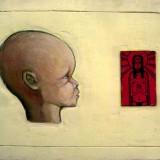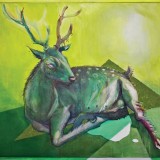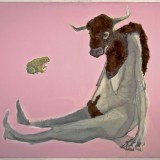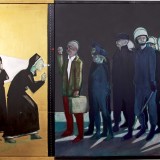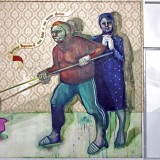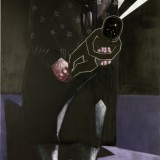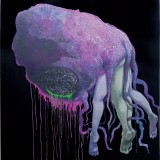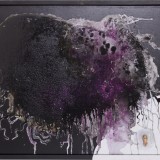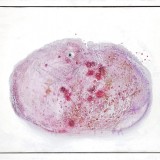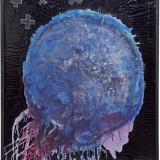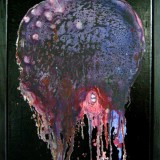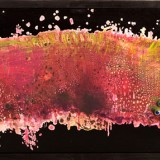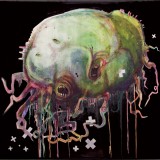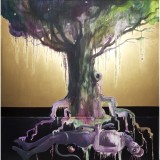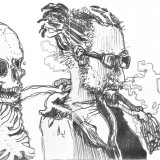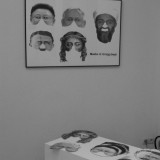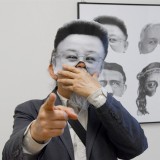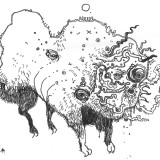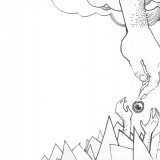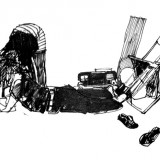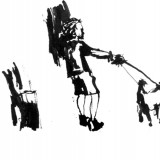Jan Jubaal Wasiński
Born in 1983. He is a graduate of the College of Theatre and Film Techniques in £ód¼. In 2009 he graduated with honours from the Department of Graphics and Painting within the Academy of Fine Arts in £od¼. He studied at the Studio of Painting run by Prof. Ryszard Hunger, with complementary studies in the Studio of Screen Printing Techniques run by Prof. Andrzej Smoczyński. He has received awards from many artistic competitions. In 2007 he received a scholarship from the Polish Ministry of Culture and National Heritage. He has had a few solo shows and participated in over 30 group shows in Poland and abroad. Since 2012 he has been an assistant professor in the Studio of Painting and Drawing run by Prof. J. Chrab±szcz, at the Department of Fabric and Clothing within the academy that he graduated from. He works in the media of painting, graphics, drawing and installation art.
Janek Wasiński’s works are characterised by an expression of gesture and lively, sometimes bright colours. It is figurative painting. Even in the paintings from his last years of studies one could see his interest in sacred themes (Lent Series, 2006). The biblical motifs, godly figures and saints were contrasted with elements of folk art and animals which gain symbolic meaning. The works evoke associations with folk spirituality, in which the accounts from canon texts are mixed with legends and pagan sorceries. Monsters and beasts which appear in medieval beast books or in the paintings by Hieronymus Bosch are revived in the imagination of this contemporary artist. Jan Wasiński in his works suggests that good and beauty cannot be distinguished without the existence of evil and ugliness, brightness cannot exist without the sphere of shadow. This dark sphere of faith and the human psyche attracts him more. The evil which lives under the sun…
In the painting The Pacification of the Congregation of Sisters of the Bethany Family presented during the Artistic Meetings “Aspects” in 2008, the artist began to reflect over the relationships between official church teaching rooted for centuries in Polish society, paranormal phenomena such as miracles and possessions, and the media, in particular tabloids which hunt for sensations. The painting refers to the media madness which broke out after news concerning a “heresy” in the Congregation of Sisters of the Bethany Family. Legends about alleged sexual practices in the nunnery and the tales by the mother superior about her visions of dragons and demons added to the flavour. Jan Wasiński showed his own version of the story. The left section of the painting which was divided into two parts was taken up by “besieged” sisters and a priest,gathered behind a closed door. On the other side were the representatives of the authorities and antiterrorist brigade ready to force the door. Both groups look at each other through an eyehole. One group rebelled against the rule, the other wanted to bring order to the situation. A found item – a plastic eye, attracts one’s attention in the painting.
Found objects (objects trouvé) used by surrealists appear also in other paintings by Wasiński. The painting The defeater of the devil was inspired by a tragic event in W³oc³awek. The artist recalls: “One morning I was woken up by news on the radio which went more or less like this: a man called the police station and said that in his room there is a corpse of a devil which he and his wife had killed. It turned out that there was no devil, but the corpse of a 4-year old girl Ania, who was the daughter of their neighbours and who had stayed with them for the night. The man during his arrest and a day after, still stated that he killed a devil.” The painting which referred to this horrifying event was divided by the artist into three parts. The largest presents a scene inspired by the presentations of St. George’s and Archangel Michael’s fights with the dragon, smaller quarters show an axe attached to the painting and a child holding a green rat by hand. The scene is made more contemporary by the use of wallpaper in the background and the outfit – the track suit trousers and slippers of the “defeater”. Contemporary pathologies, laid over medieval iconography create a scary image of the world seemingly lay, deprived of spirituality, but at the same time, full of dark secrets and cruelty.
Destructive powers lurk not only in our brains but also in our bodies and are very real and tangible. The series Virus-Demons is filled with creatures as if they were taken from medieval beast books. The demons of which we are very afraid, are cancers and viruses. With horror we take in information about the new mutation of tuberculosis. Listening to the news we are afraid of attacks of bird or pig flu or lurking salmonella bacteria or herpes viruses. Not even to mention the almost certain death sentence – HIV. These viruses – made possible to photograph only by enlargement, the artist paints on large scale canvas. Sometimes these are only viruses and bacteria, another times the artist confronts scholarly knowledge with biblical motifs, just like in the paintings The Tree of Life, The Tree of the Knowledge and serigraphs entitled Adam and Eve. The bodies of the first people are not entirely human. Eve will give birth to a rat in a while, Adam in place of a heart has some strange green object implanted. The artist seems to ask about the consequences of a fusion between the seemingly estranged worlds of biology and technology.
In one of the later works - Mask of Living Death (serigraphy, paper masks) he referred to the icons of death which exist in the consciousness of humankind. The artist made masks of Hitler, Kim Jong Il, Bin Laden, Lech Kaczyński and Jesus Christ, which viewers could put on. By joining together in one work the images of dictators, terrorists, criminals and Jesus the artist makes us aware that what connects these figures is the aura of death – the criminal, the martyred, the tragic, well known to people on all continents.
Janek Wasiński also aptly draws. In black and white sketches he freezes the gestures, facial expressions and situations with which he builds narrations and painting compositions. Despite the dark themes of his work, which reveal what we would prefer not to think about for our own comfort, Jan Jubaal Wasiński is a cheerful, positive man. His other passion, next to visual arts is music, especially roots, reggae, dub and other Jamaican sounds. The artist collects old vinyl disks, experiments with music as a DJ / Selector (under a nickname Jubaal) during club events.
Anka Le¶niak


